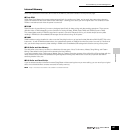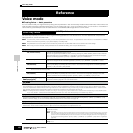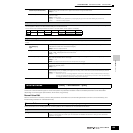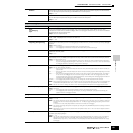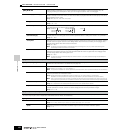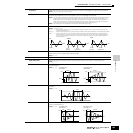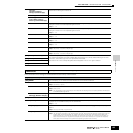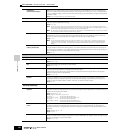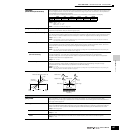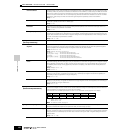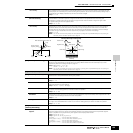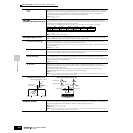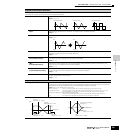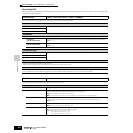
Reference Voice Mode
Voice Edit mode Normal Voice Edit Element Edit
195
Owner’s Manual
These parameters are for editing the individual Elements that make up a Normal Voice.
InsB Ctgry
(Insertion B Category),
InsB Type (Insertion B Type)
Determines the effect type for Insertion B.
Reverb Type Determines the effect type for Reverb.
Chorus Ctg
(Chorus Effect Category),
Chorus Typ (Chorus Effect Type)
Determines the effect type for Chorus.
Reverb Send Determines the level of the sound (from Insertion A or B, or the bypassed signal) that is sent to Reverb effect. A
setting of “0” results in no Reverb processing of the sound.
Settings: 0 ~ 127
Chorus Send Determines the level of the sound (from Insertion 1 or 2, or the bypassed signal) that is sent to Chorus effect. A
setting of “0” results in no Chorus processing of the sound.
Settings: 0 ~ 127
Reverb Return Determines the Return level of the Reverb Effect.
Settings: 0 ~ 127
Chorus Return Determines the Return level of the Chorus Effect.
Settings: 0 ~ 127
Chorus to Reverb Determines the Send level of the signal sent from the Chorus Effect to the Reverb Effect.
Settings: 0 ~ 127
Reverb Pan Determines the pan position setting for the Reverb effect.
Settings: L63 (far left) ~ cnt (center) ~ R63 (far right)
Chorus Pan Determines the pan position setting for the Chorus effect.
Settings: L63 (far left) ~ cnt (center) ~ R63 (far right)
[SF2] INS A (Insertion A)
These are for adjusting the various parameters of the Effect blocks.
The number of parameters and values available differs depending on the currently selected effect type. For more
information, see the Effect Type List in the separate Data List booklet.
Note that the menu of the corresponding Effect block disappears when the “thru” type is selected.
[SF3] INS B (Insertion A)
[SF4] REVERB
[SF5] CHORUS
Element Edit
[VOICE] → Normal Voice selection → [EDIT] → Element selection
[F1] OSC (Oscillator)
[SF1] WAVE
From this display you can select the desired waveform or sound used for the Element.
ElementSw (Element Switch) Determines whether the currently selected Element is on or off.
Settings: off (inactive), on (active)
Bank Determines whether the Preset Waveform or User Waveform is used.
Settings: preset, usr wav
n The User Waveform contains audio data you have created with the Sampling function or imported (as WAV or AIFF files) from
a SmartMedia/USB storage device.
Wave No. (Waveform Number),
WaveCtgry (Waveform Category)
Determines the Waveform for the selected Element. See the Waveform list in the separate Data List.
[SF2] OUTPUT
From this display you can set certain output parameters for the selected Element.
KeyOnDelay Determines the time (delay) between the moment you press a note on the keyboard and the point at which the sound
is played. You can set different delay times for each Element.
Settings: 0 ~ 127
DelayTempoSync Determines whether or not the KeyOnDelay is synchronized to the tempo of the Arpeggio or sequencer (song or
pattern).
Settings: off (not synchronized), on (synchronized)
DelayTempo Determines the timing of the KeyOnDelay when the DelayTempoSync is set to on.
Settings: 16th, 8th/3 (eighth-note triplets), 16th. (dotted sixteenth notes), 8th, 4th/3 (quarter-note triplets), 8th. (dotted eighth notes), 4th
(quarter notes), 2nd/3 (half-note triplets), 4th. (dotted quarter notes), 2nd (half notes), whole/3 (whole-note triplets), 2nd.
(dotted half notes), 4th x 4 (quarter-note quadruplets; four quarter notes to the beat), 4th x 5 (quarter-note quintuplets; five
quarter notes to the beat), 4th x 6 (quarter-note sextuplets; six quarter notes to the beat), 4th x 7 (quarter-note septuplets;
seven quarter notes to the beat), 4th x 8 (quarter-note octuplets; eight quarter notes to the beat)



